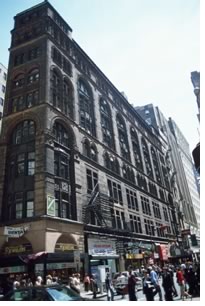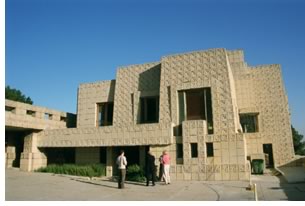

Call to the Rescue: World Monuments Fund Issues List of 100 Endangered Sites
 For
the first time in its eight-year history, the World Monuments Watch list
for 2004 encompasses sites on all seven continents, from ancient palaces
in Iraq to an early 20th-century explorer’s hut in Antarctica, Frank
Lloyd Wright’s Ennis Brown House in California, and historic lower
Manhattan. The 100 places on this year’s endangered list, say officials
from the World Monuments Fund, reflect a broad geography and cultural
scope, giving wide definition to the term “cultural-heritage monument.”
For
the first time in its eight-year history, the World Monuments Watch list
for 2004 encompasses sites on all seven continents, from ancient palaces
in Iraq to an early 20th-century explorer’s hut in Antarctica, Frank
Lloyd Wright’s Ennis Brown House in California, and historic lower
Manhattan. The 100 places on this year’s endangered list, say officials
from the World Monuments Fund, reflect a broad geography and cultural
scope, giving wide definition to the term “cultural-heritage monument.”
“The World Monuments Watch program identifies a stunning range of endangered sites and brings them to the attention of the public, preservation professionals, and local governments,” says WMF President Bonnie Burnham. In addition to the first site in Antarctica, the 2004 Watch list features for the first time sites in Australia, Ecuador, Finland, the Palestine Territories, Paraguay, Slovenia, South Africa, Taiwan, and Trinidad and Tobago. In addition to the sites in Australia and Antarctica, the list comprises 33 places in Europe, 16 in Asia, 18 in Africa and the Middle East, and 31 in the Americas. WMF officials say designation as an endangered site brings more exposure to the plight of the site and often helps bring funding and expert attention to the effort to save it. The Watch list is published biennially and sponsored by American Express.
 Modern
architecture theme
Modern
architecture theme
“A theme that emerged from the 2002 list was Modern architecture,
and that is even more notable on this list. Most people associate historic
preservation with buildings that are hundreds of years old and are surprised
to see buildings constructed during their lifetimes on the list. But modern
architecture is now a part of the spectrum of cultural heritage,”
says John Stubbs, WMF vice president of programs. He notes that the 2004
list includes several 20th century buildings of variety of types, such
as London’s Battersea Power Station on the Thames. The power station
was “quite controversial” when it was built, he says, but
is now stands as one of the city’s most cherished spaces, “popularly
recognized as a masterpiece of industrial architecture and an example
of a well-designed civic building.”
 The
Watch list also includes Frank Lloyd Wright’s Ennis Brown House
in Los Angeles, the largest of four textile block houses that test the
architect’s theories of organic architecture. The house features
decomposed granite blocks from the site, so that the exterior matches
the color and texture of the surrounding hills. The house has 27 art-glass
windows, all of which remain in situ. Officials note, however, that the
very materials Wright used to build the house have contributed to its
deterioration and that structural damage from the 1994 Northridge earthquake
has only compounded the problems. Support from local foundations and state
funding, as well as federal emergency funds, has helped the Trust for
Preservation of Cultural Heritage secure the services of Eric Lloyd Wright
and a team of specialists to help rehabilitate and preserve the weakened
concrete blocks, but a great deal more money is needed to complete seismic
retrofitting and stabilize the house.
The
Watch list also includes Frank Lloyd Wright’s Ennis Brown House
in Los Angeles, the largest of four textile block houses that test the
architect’s theories of organic architecture. The house features
decomposed granite blocks from the site, so that the exterior matches
the color and texture of the surrounding hills. The house has 27 art-glass
windows, all of which remain in situ. Officials note, however, that the
very materials Wright used to build the house have contributed to its
deterioration and that structural damage from the 1994 Northridge earthquake
has only compounded the problems. Support from local foundations and state
funding, as well as federal emergency funds, has helped the Trust for
Preservation of Cultural Heritage secure the services of Eric Lloyd Wright
and a team of specialists to help rehabilitate and preserve the weakened
concrete blocks, but a great deal more money is needed to complete seismic
retrofitting and stabilize the house.
Historic Lower Manhattan, which was added to the 2001 list as a special 101st site, continues on this year’s roll, with its more than 65 landmark buildings in six historic districts. “Together, its buildings chronicle the evolution of American architecture and, in many ways, the United States itself over a 375-year period,” Burnham says. The listing is intended to call attention to the importance of the historic sites as the planning and redevelopment process goes forward.
Copyright 2003 The American Institute of Architects.
All rights reserved. Home Page ![]()
![]()
 |
||
| Visit wmf.org
for the complete 2004 World Monuments Watch List.
|
||